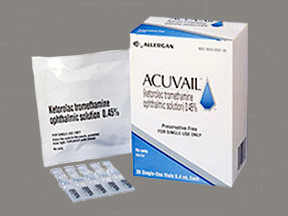KETOROLAC 0.45% PRESERVATIVE-FREE SOLUTION - OPHTHALMIC
PHONETIC PRONUNCIATION: (KEE-toe-ROLE-ak)
COMMON BRAND NAME(S): Acuvail
GENERIC NAME(S): ketorolac tromethamine/PF
Uses
USES: This medication is used to treat eye pain and swelling (inflammation) after cataract surgery. Ketorolac belongs to a class of drugs known as nonsteroidal anti-inflammatory drugs (NSAIDs). It works by blocking certain natural substances in your body to reduce pain and swelling.
How to use KETOROLAC 0.45% PRESERVATIVE-FREE SOLUTION - OPHTHALMIC
HOW TO USE: Apply this medication to the affected eye as directed by your doctor, usually twice daily starting 1 day before surgery, continuing on the day of surgery, and then for 2 weeks after surgery. To apply eye medication, wash your hands first. To avoid contamination, do not touch the dropper tip or let it touch your eye or any other surface. Do not wear contact lenses while using this medication. Sterilize contact lenses according to the manufacturer's directions, and check with your doctor before you begin using them again. Tilt your head back, look upward, and pull down the lower eyelid to make a pouch. Hold the dropper directly over your eye and place one drop into the pouch. Look downward, gently close your eyes, and place one finger at the corner of your eye (near the nose). Apply gentle pressure for 1 to 2 minutes before opening your eyes. This will prevent the medication from draining out. Try not to blink or rub your eye. Wait several minutes for your vision to clear before driving or operating machinery. For single-use vials, open the vial right before use. After use, discard any remaining solution right away. Do not keep an opened vial for later use. If you are using another kind of eye medication (such as drops or ointments), wait at least 5 minutes between applying each medication. Use eye drops before eye ointments to allow the drops to enter the eye. Do not use this medication more often or for longer than directed by your doctor. This medication is usually used only for a short time. Prolonged use may slow or delay healing and may increase your chance of serious side effects. Tell your doctor if your condition persists or if it worsens (for example, you develop worsening eye pain/itching/swelling).
Side Effects
Precautions
Interactions
Overdose
Images
Reviews
Disclaimer
IMPORTANT: HOW TO USE THIS INFORMATION: This is a summary and does NOT have all possible information about this product. This information does not assure that this product is safe, effective, or appropriate for you. This information is not individual medical advice and does not substitute for the advice of your health care professional. Always ask your health care professional for complete information about this product and your specific health needs.


No Reviews Yet